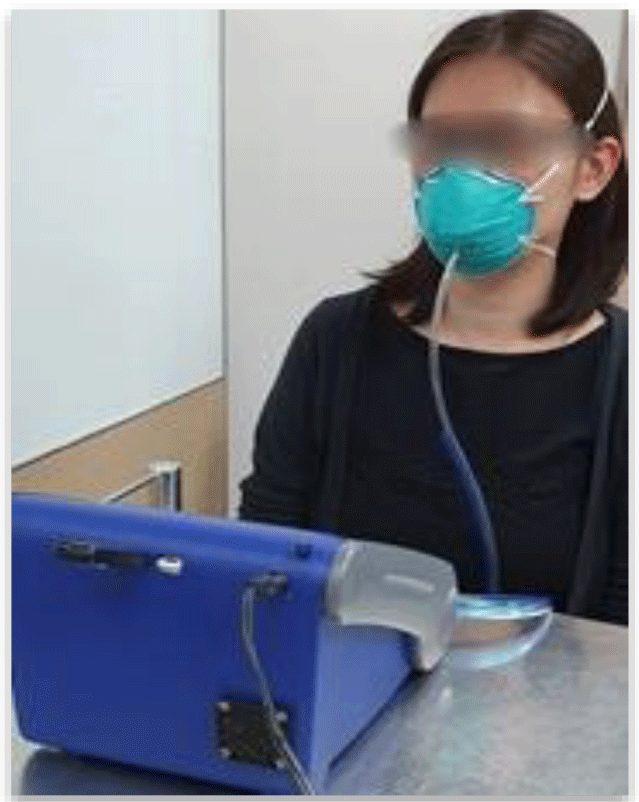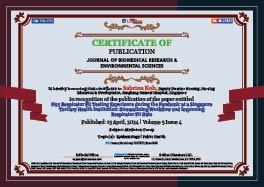Medicine Group. 2024 April 15;5(4):303-306. doi: 10.37871/jbres1896.
N95 Respirator Fit Testing Experience during the Pandemic at a Singapore Tertiary Health Institution: Streamlining Workflow and Improving Respirator Fit Rate
Wang Cuixia1, Sharon Wong2, Nurhuda Binte Mohamed Abdul Wahab3 and Sabrina Koh4*
2Senior Nurse Clinician, Infection Prevention & Control, Singapore
3Nurse Clinician, Nursing Division, Singapore
4Deputy Director Nursing, Nursing Education & Development, Singapore
Abstract
The N95 respirator is imperative for Healthcare Professionals (HCPs) when caring for patients with potentially airborne infectious diseases such as COVID-19. During the onset of the COVID-19 pandemic, HCPs were anxious and unsure if their N95 respirator still fits well. In addition, as a result of the sharp increase in demand and consequent supply disruptions for some N95 respirator models, alternative respirator models were sourced and brought in at different intervals. The Infection Prevention & Control Department (IPCD) had to react to the situation by conducting impromptu mass fit testing sessions for affected HCPs.
Quick turnaround strategy using online pre-registration for respirator fitting had helped to make the N95 respirator fit test procedure more seamless. The introduction of quantitative fit testing had also enhanced the success rate of fitting, with the majority of HCPs previously could not be successfully fitted with a N95 respirator, being now successfully fitted.
Introduction
In the course of frontline care provision, Healthcare Professionals (HCPs) protect themselves against infectious diseases by donning Personal Protective Equipment (PPE). In potentially airborne infectious diseases, the N95 respirator is a crucial component of PPE for all HCP. As the route of transmission for the viral pathogen, SARS-COV-2, was determined as airborne [1] donning the N95 respirator in conjunction with gown and gloves became the gold standard in providing HCPs greater protection against the virus [2]. During the peak of the COVID-19 pandemic, in a bid to prevent staff-patient transmission, the donning of N95 respirators was mandated in all clinical areas.
Background and Challenges
Globally, N95 respirators were highly utilized in the clinical areas during the COVID-19 pandemic. Inevitably, regular respirator models supply was disrupted and resulting from the sharp increase in demand and consequent supply disruptions for some N95 respirator models, alternative respirator models were sourced and brought in at different intervals. Many acute care institutions required patient-fronting HCPs to be fitted with alternate respirator models, so that clinical care provision remains safe for the HCPs in the event of discontinuity or interruption to the supply of any specific respirator models [3].
During the COVID-19 pandemic, N95 respirator supply was unstable with frequent change in respirator models and manufacturer. The Infection Prevention & Control Department (IPCD) at Sengkang General Hospital (SKH) reacted to the high demand for respirator fit testing services by conducting impromptu respirator fit testing sessions, in addition to the routinely scheduled monthly session, for affected HCPs.
Many of these sessions saw over 200 patient-fronting HCPs attending respirator. The overcrowding made it difficult to comply with safe distancing measures (Figure 1). The congregation of staff over a prolonged period of time posed as a risk for potential COVID-19 clusters to form, which in turn could negatively impact available manpower in clinical areas and might compromise the delivery of patient care. HCPs were also unhappy over the long queues and the time taken for their turn to be fit tested.
The ratio of mask trainers to the number of HCPs waiting to be fitted was greatly disproportionate. Due to the huge demand for their services. Mask trainers were pressed to complete fitting for each HCP as quickly as possible respirator and were forced to compromise in the provision of quality training given to HCPs.
The IPCD utilizes Qualitative Fit Testing (QLFT) using the denatonium benzoate (Bitrex®) solution (Figure 2). During the fit testing process, staff who tasted the Bitrex® solution were deemed to have failed the particular respirator model. At the onset of the COVID-19 pandemic, many HCPs were unsure if previously fitted N95 respirator still fits well, furthermore, the subjective self-reporting on tasting of the Bitrex® solution may not be reliable for some individuals due to varied perception of taste. We also suspected that HCPs could have experienced anxiety during the time of pandemic and they were unsure of the self-reported QLFT and would like to be assured of proper respirator fitting. The refitting took up additional time and resources.
Implementation of improvements
From the various problems encountered during the impromptu respirator fitting, the IPCD identified strategies targeted at reducing overcrowding, providing HCPs education on the new respirator types and to enhance HCPs confidence on the respirator fitting procedure.
SKH adopted strict pandemic safety measures (social distancing); to allow good spacing and more organized respirator fitting experience, the IPCD introduced a pre-registration system using a common survey platform (i.e. FormSG). HCPs can register to attend a 30-minute slot for the respirator fitting. This spaced out the number of attendees across the session and ensured that there was compliance to safe distancing. The waiting time for staff to be fit tested also decreased significantly. The online pre-registration workflow provides added benefit of: (i) removing the need for paper forms (Go Green); (ii) efficient data entry without human error due to illegible handwriting or inaccurate information and (iii) enabling IPCD to estimate demand for respirator fitting services for each session and allocate manpower accordingly.
To increase the available slots for respirator fitting, more respirator trainers were certified to cater for more stations; trainers are also empowered to fit test their colleagues in the wards. These strategies greatly reduced overcrowding and allow respirator trainers to spend more time with each attendee to ensure attendees were well-versed in donning and doffing their respirator properly.
The new registration process, respirator fitting schedule and pre-registration link were loaded on the SKH intranet landing page along with FAQ on respirator fitting requirements and links to review videos on N95 respirator wearing. This had prepared HCPs ahead of their respirator fitting session to anticipate the requirements of respirator fitting. Following the initial 2 weeks of email blast reminders for pre-registration HCPs adjusted to the new process and positive feedback was received that the new process was seamless. Attendees also benefitted from the convenience of having certified respirator trainers at their ward level as it meant that they are not required to take too much time away from their clinical work for the refitting session (Figure 3).
Quantitative respirator fit testing method
IPCD revised the respirator fitting process to include the Quantitative Fit Test (QNFT) method. The QNFT employs the use of the PortaCount® device which is a closed system that measure possible leaks from the respirator and provides a report that states objectively, the outcome of the respirator fitting [4]. The objective report provides objective indication on respirator fitting outcome and it does not rely on HCPs self-reporting on was conducted in good order and they should proceed with wearing the fitted respirator type with good confidence.
During pre-COVID-19 respirator fitting and prior to using the PortaCount® system, HCPs who failed N95 respirator fit testing had to use Powered Air-Purifying Respirators (PAPR) when providing clinical care. Mandate use of N95 respirators during the pandemic would translate to this group of staff using the PAPR throughout the shift. The PAPR has a battery span that requires charging at intervals. Furthermore, there is additional equipment weight imposing on the HCPs causing pain and discomfort. Fit testing outcomes using the PortaCount® has good successful rate of respirator fitting, HCPs who were previously assessed as unsuitable for qualitative respirator fitting, having failed all available N95 respirators, were re-fitted using the PortaCount®. 72% of HCPs from this group (n = 39) were successfully fitted with a N95 respirator and could stop wearing PAPR.
Summary
Positive feedback was received that new process was smoother, staff knew what to expect and the FAQ helped answer some staff queries before they attended the session. The improved workflow is also robust, being able to accommodate unforeseen circumstances such as having to conduct unanticipated massive re-fitting for staff. The use of PortaCount® quantitative fit-test method has led to a significant improvement in the reduction of rejection rate and simultaneously had an increase success rate during the fit test. HCPs that had previously failed their respirator fitting were able to do away with PAPR.
The new workflow has been in use since its implementation, with no plans to stop so long as there is access to the online registration platform using the FormSG. It can be scaled up as needed in the event that there needs to be massive respirator-fitting for staff.
References
- Bahl P, Doolan C, de Silva C, Chughtai AA, Bourouiba L, MacIntyre CR. Airborne or Droplet Precautions for Health Workers Treating Coronavirus Disease 2019? J Infect Dis. 2022 May 4;225(9):1561-1568. doi: 10.1093/infdis/jiaa189. PMID: 32301491; PMCID: PMC7184471.
- Khan MM, Parab SR. Simple Economical Solution for Personal Protection Equipment (Face Mask/Shield) for Health Care Staff During COVID 19. Indian J Otolaryngol Head Neck Surg. 2022 Oct;74(Suppl 2):2676-2680. doi: 10.1007/s12070-020-01863-4. Epub 2020 Apr 27. PMID: 32346531; PMCID: PMC7185905.
- de Perio MA, Dowell CH, Delaney LJ, Radonovich LJ, Kuhar DT, Gupta N, Patel A, Pillai SK, D'Alessandro M. Strategies for Optimizing the Supply of N95 Filtering Facepiece Respirators During the Coronavirus Disease 2019 (COVID-19) Pandemic. Disaster Med Public Health Prep. 2020 Oct;14(5):658-669. doi: 10.1017/dmp.2020.160. Epub 2020 May 19. PMID: 32423515; PMCID: PMC7303467.
- 3M. Quantitative fit testing of respirators. Technical Bulletin. 2021.
Content Alerts
SignUp to our
Content alerts.
 This work is licensed under a Creative Commons Attribution 4.0 International License.
This work is licensed under a Creative Commons Attribution 4.0 International License.











